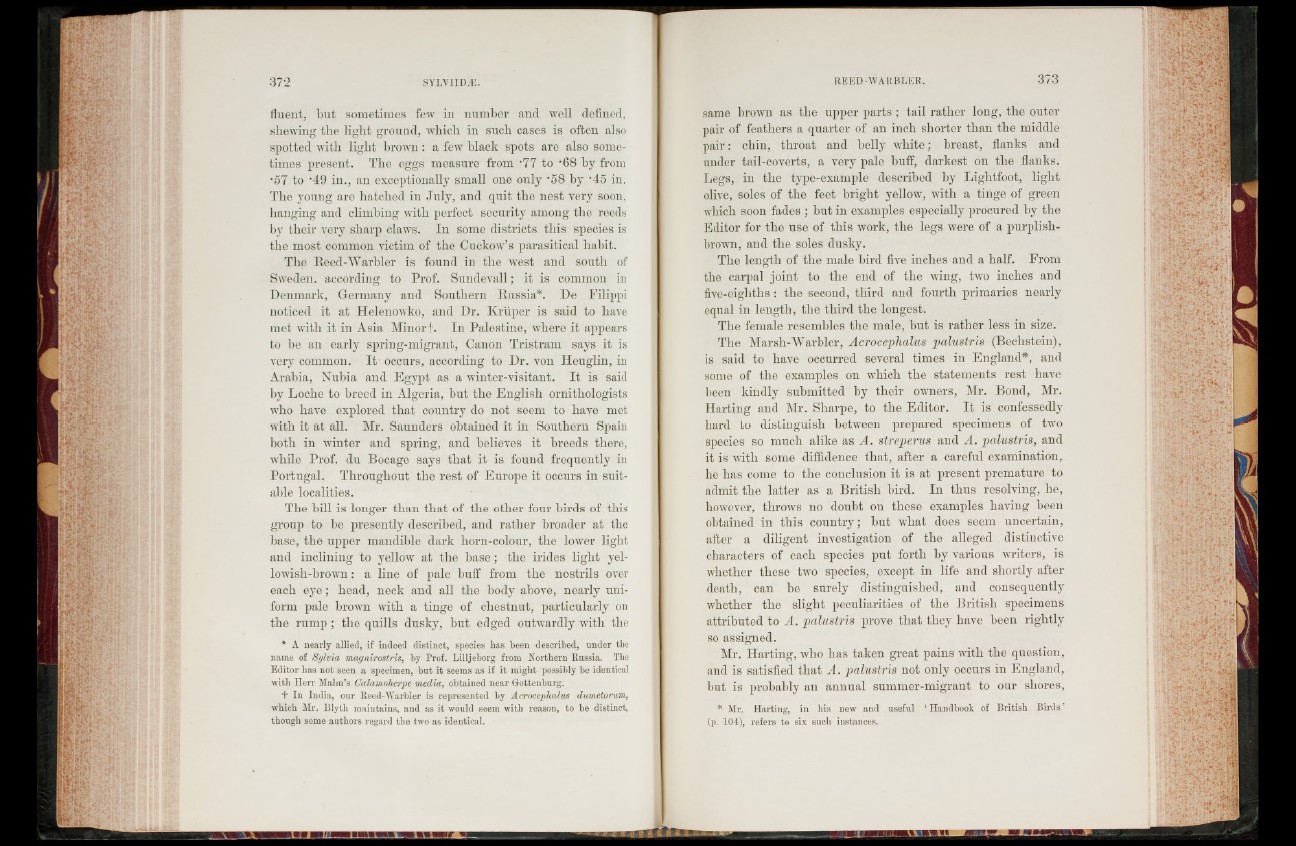
fluent, but sometimes few in number and well defined,
shewing the light ground, which in such cases is often also
spotted with light brown: a few black spots are also sometimes
present. The eggs measure from -77 to '68 by from
•57 to -49 in., an exceptionally small one only -58 by -45 in.
The young are hatched in July, and quit the nest very soon,
hanging and climbing with perfect security among the reeds
by their very sharp claws. In some districts this species is
the most common victim of the Cuckow’s parasitical habit.
The Reed-Warbler is found in the west and south of
Sweden, according to Prof. Sundevall; it is common in
Denmark, Germany and Southern Russia*. De Filippi
noticed it at Helenowko, and Dr. Krliper is said to have
met with it in Asia Minor f. In Palestine, where it appears
to be an early spring-migrant, Canon Tristram says it is
very common. I t occurs, according to Dr. von Heuglin, in
Arabia, Nubia and Egypt as a winter-visitant. I t is said
by Loche to breed in Algeria, but the English ornithologists
who have explored that country do not seem to have met
with it at all. Mr. Saunders obtained it in Southern Spain
both in winter and spring, and believes it breeds there,
while Prof. du Bocage says that it is found frequently in
Portugal. Throughout the rest of Europe it occurs in suitable
localities.
The bill is longer than that of the other four birds of this
group to be presently described, and rather broader at the
base, the upper mandible dark horn-colour, the lower light
and inclining to yellow at the base; the irides light yellowish
brown : a line of pale buff from the nostrils over
each eye; head, neck and all the body above, nearly uniform
pale brown with a tinge of chestnut, particularly on
the rum p ; the quills dusky, but edged outwardly with the
* A nearly allied, if indeed distinct, species has been described, under tbe
name of Sylvia magnirastris, by Prof. Lilljeborg from Northern Russia. The
Editor has not seen a specimen, but it seems as if it might possibly be identical
with Herr Malm’s Calamoherpe media, obtained near Grottenburg.
+ In India, our Reed-Warbler is represented by Acrocephalus dumetorum,
which Mr. Blyth maintains, and as it would seem with reason, to be distinct,
though some authors regard the two as identical.
same brown as the upper p a rts ; tail rather long, the outer
pair of feathers a quarter of an inch shorter than the middle
pair: chin, throat and belly white; breast, flanks and
under tail-coverts, a very pale buff, darkest on the flanks.
Legs, in the type-example described by Lightfoot, light
olive, soles of the feet bright yellow, with a tinge of green
which soon fades ; but in examples especially procured by the
Editor for the use of this work, the legs were of a purplish-
brown, and the soles dusky.
The length of the male bird five inches and a half. From
the carpal joint to the end of the wing, two inches and
five-eighths: the second, third and fourth primaries nearly
equal in length, the third the longest.
The female resembles the male, but is rather less in size.
The Marsh-Warbler, Acrocephalus palustris (Bechstein),
is said to have occurred several times in England*, and
some of the examples on which the statements rest have
been kindly submitted by their owners, Mr. Bond, Mr.
Harting and Mr. Sharpe, to the Editor. I t is confessedly
hard to distinguish between prepared specimens of two
species so much alike as A. streperus and A. palustris, and
it is with some diffidence that, after a careful examination,
he has come to the conclusion it is at present premature to
admit the latter as a British bird. In thus resolving, he,
however, throws no doubt on these examples having been
obtained in this country; but what does seem uncertain,
after a diligent investigation of the alleged distinctive
characters of each species put forth by various writers, is
whether these two species, except in life and shortly after
death, can be surely distinguished, and consequently
whether the slight peculiarities of the British specimens
attributed to A. palustris prove that they have been rightly
so assigned.
Mr. Harting, who has taken great pains with the question,
and is satisfied that A. palustris not only occurs in England,
but is probably an annual summer-migrant to our shores,
* Mr. Harting, in his new and useful ‘ Handbook of British Birds ’
(p. 104), refers to six such instances.
& .* i
•l r
■ ■«*„- ‘..'■b-'-to# My -
• ]
i ■
1
• * T M . '-w
: • ,
3
-
v - ; ; : y
i* :
’"V 2
/
( T
■
¡¡j
: ' '
\ M